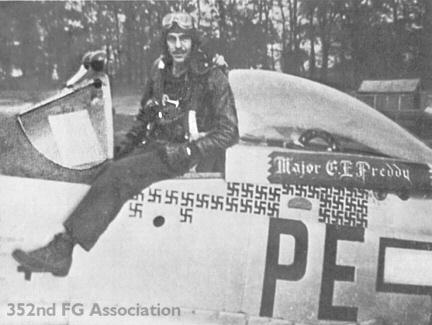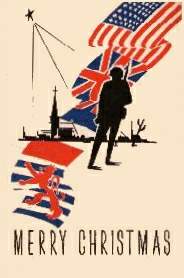

� � � The 101st. Airborne Division had entered Bastogne, but the Germans quickly set seige to the town and by Friday, the 22nd, Allies report that the Germans have penetrated up to 40 miles in the Ardennes. The U.S. 3rd Army began an offensive to relieve Bastogne and the British Forces began a call-up of 250,000 troops as reinforcements. � � � By Christmas Eve the 2nd. Panzer Division had moved to within a few miles of the river Meuse, Southwest of Liege. The U.S. 2nd Armoured Division, along with British help were moving to stop them. � � � The dense fog which covered all of England and Europe had the Allied Air Forces grounded. Allied fighter and bomber pilots, eager to help their brothers in trouble on the ground watched the weather anxiously and finally, on Christmas Eve word arrived from Headquarters. � � � "The sun came out on the 24th of December in England and Europe.�General Eisenhower ordered maximum effort that every plane possible was to fly that day. Those of us landing at Bath were briefed and the orders were to form composite groups of the planes from the various Bomb Groups into one unit. The bombers, from where ever they were located, were assigned to various targets.�No one needed a second invitation and we were soon on our way.�This time the weatherman told us there appeared only a 10% chance the weather would remain clear by the end of the day.�We took off from where ever we were and assembled into composite groups our target was Kaiserslautern (our bomb group went to four different targets that day.). We never reached the IP of our assigned target, as there was nothing but solid clouds below us.� The target was changed to any target of opportunity, so we ended up dropping our bombs on a crossroads." B-17 crewman Wally Hoffman recounts. "As we crossed the channel there was nothing ahead of us but a solid cloud cover where England should be."
� � � The next morning, Christmas Day, the skies above England and Europe were clear. The men of the 20th. Fighter Group took off from Wormingford, where they had landed the night before. In the air over Belgium and Luxembourg they encountered 350 Luftwaffe planes but didn't lose a single pilot. By the 27th. they were finally back in their own bunks at King's Cliffe. � � � Christmas Day 1944 was disastrous for two 8th Air Force aces. Captain Donald Emerson, 336th FS, 4th FG and Major George Preddy 328th FS, 352nd FG were both shot down by friendly fire. � � � Major George Preddy, 328th FS/352nd FG,had the highest number of air victories in a P-51. He was credited with 27 aerial plus 5 ground victories. George won his wings five days after Pearl Harbor was attacked. He flew a P-40 near Darwin, Australia for several months until a mid-air collision ended his Pacific tour. A year later he flew a P-47 from Bodney, England with the 352nd Fighter Group. During his tour here he saved a B-24 while facing six-to-one odds and received the Silver Star. He started flying P-51s in the Spring of 1944. On August 6th he dove into a group of 30 plus ME-109s that were heading for the bomber group he was to rendezvous with near Hamburg. He shot down six ME-109s within five minutes. George received the Distinguished Service Cross for his courage. During the Battle of the Bulge in December of 1944, George's group flew out of Belgium to assist Allied ground forces. While fighting over Coblenz on Christmas Day, he shot down two ME-109s and gave chase to a FW-190. As he dove in pursuit he was shot down accidentally by American anti-aircraft guns shooting at the 190. He was fatally wounded.
 Maj. George Preddy, top-scoring Mustang ace of the war. � � � What follows is a quick look at Christmas as it was 55 years ago, from the eyes of a young English boy, a bomber crewman, and a former 20th. Fighter Group pilot who had already made it back to the United States but still was not be able to celebrate with his family. � � � As each of us sits down to dinner with those we love and celebrate the holiday season, I ask you to keep in mind the sacrifices that these great and brave men made for us all and that you remember those who never saw another Christmas. � � � I would like to thank Bill Sharpe, Wally Hoffman and Arthur Heiden for sharing their experiences with us for this special holiday addition to these websites. I hope you enjoy it.
|
RETURN TO NEWS � RETURN TO THE 20TH.FG � RETURN TO THE 1ST.FG
Unless otherwise noted, all content � copyright The Art of Syd Edwards 1998-1999. All rights reserved and reproduction is prohibited.

 � � � By mid-December, 1944 the weather in the European Theater had turned dismal. Winter had set in with a fury and the last German offensive was underway. Three German Armies conducted a surprise attack along a 50 mile front in the Ardennes on Saturday, December 16th. and quickly overtook thin U.S. lines. This became known as the "Battle of the Bulge".More than a million men, 500,000 Germans, 600,000 Americans (more than fought on both sides at Gettysburg) and 55,000 British fought in what turned out to be the largest land battle of World War II.
� � � By mid-December, 1944 the weather in the European Theater had turned dismal. Winter had set in with a fury and the last German offensive was underway. Three German Armies conducted a surprise attack along a 50 mile front in the Ardennes on Saturday, December 16th. and quickly overtook thin U.S. lines. This became known as the "Battle of the Bulge".More than a million men, 500,000 Germans, 600,000 Americans (more than fought on both sides at Gettysburg) and 55,000 British fought in what turned out to be the largest land battle of World War II. � � � Like Hoffman and his crew, many of the other Allied aircraft in the sky that day would find themselves having to land at any field in England they could find. Many men found themselves having to face Christmas morning not only without their families and loved ones, but without the men they had grown closer than brothers to in their own Groups.
� � � Like Hoffman and his crew, many of the other Allied aircraft in the sky that day would find themselves having to land at any field in England they could find. Many men found themselves having to face Christmas morning not only without their families and loved ones, but without the men they had grown closer than brothers to in their own Groups.